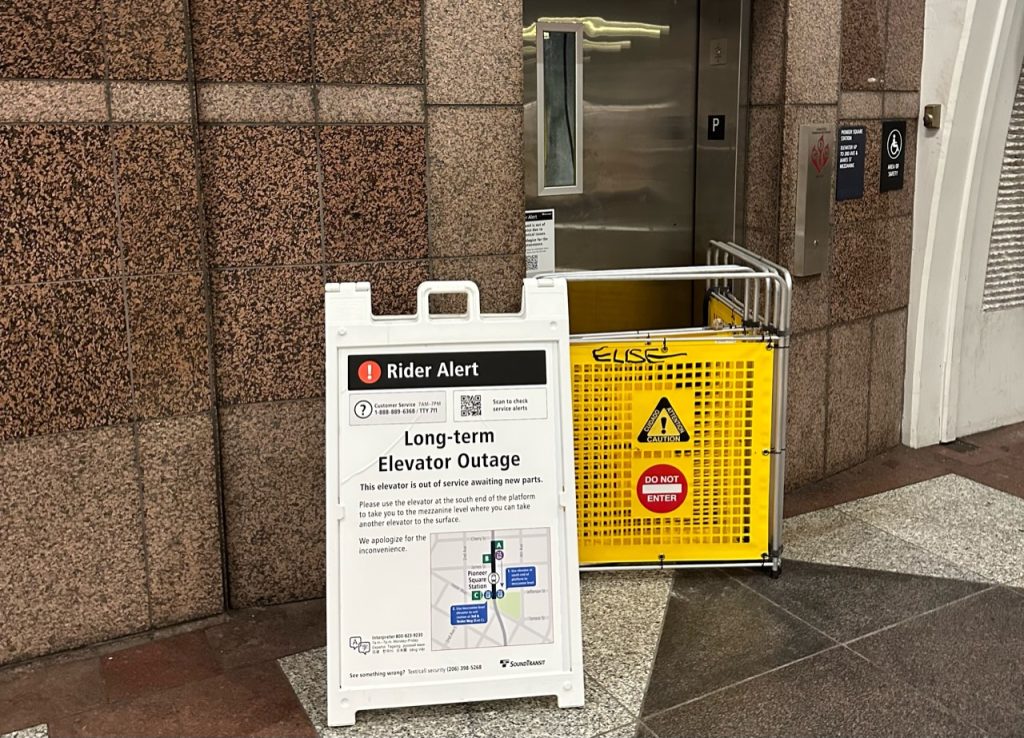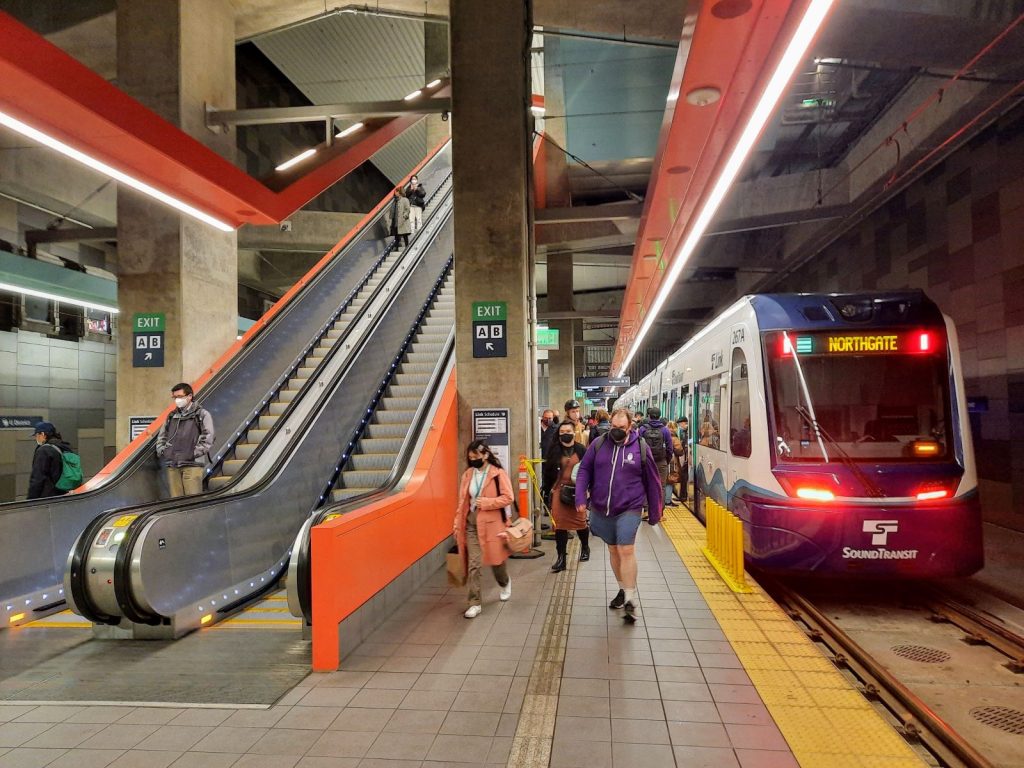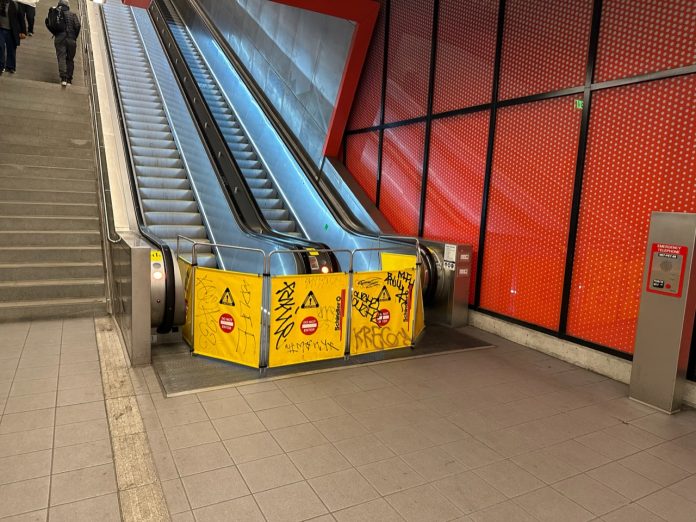A contract modification for more escalator and elevator maintenance services was approved by the Sound Transit Board of Directors in April, following a briefing and scrutiny in an agency committee earlier in the month. It will continue to improve the agency’s response to outages, but it won’t fully ameliorate the problem as aging equipment still needs replacement. Prior to approval of the contract modification, agency boardmembers were critical of the issue, citing high costs among other complaints.
Modification of the contract with Schindler nearly doubled its value through next year to $53 million. That was quite a jump considering that the contract was intended to last five years, lapsing at the end of July 2024, at a total cost of about $30 million. The agency indicated several reasons for increased contract costs.
When the original contract was signed, there were only 152 pieces of vertical conveyances covered by it. Now the agency manages a portfolio of 195 escalators and elevators needing ongoing maintenance. The modified contract now covers those, including equipment on the Northgate Link Extension and new Puyallup parking garage, as well as 33 pieces of idle equipment on the East Link extension, which was expected to open in 2023, but pushed back to 2024 or 2025 due to construction defects along I-90. The modified contract also covers additional billable hours that the agency is incurring from enhanced service response levels.
“At some point, since this is a large contract with a lot of scale, do we hope this level of scale will allow the contractor to have the staffing and do the planning that will give us improved reliability of our systems and, if they fail, to get a really timely responses and stock additional spare parts,” asked Pierce County Executive Bruce Dammeier at the full April board meeting.
“So we do currently maintain a smart inventory for our entire portfolio of assets even as they continue to grow we do look at the make, models of each asset that we take on to ensure that we have an acceptable level of spare parts maintainable assets,” Carini replied, adding that response times have been greatly improved.

Last year, Sound Transit moved from a next-day service strategy to a 24/7 on-call service strategy for vertical conveyance maintenance. That has allowed for quicker response times to called-in outages, which are typically within one hour during business hours and two hours afterhours and on weekends. In 2022 compared to 2021, the agency saw a 12% reduction in out-of-service hours for vertical conveyance equipment, translating to almost 21,000 more hours of operable equipment. That generally means more uptime for escalators and elevators, which is a principal goal of the modified contract.
Dammeier followed up to ask if the agency had any performance metrics going forward. Carini said that maintenance contractors are held to the agency’s availability standards of 95% availability generally and 97% availability for mechanical failures.
“From my perspective, what we’ve done and what we’ve been doing in the past is not working,” said University Place Councilmembmer Kent Keel. “These conveyances are broken too often and stay broken too long and impact too many people getting to and from the products we offer. And my hope is that this contract will begin to address that.”
Keel continued to say that he didn’t think the contract will solve all of the problems.
“Over the years, we’ve all had a lot of conversations about this topic,” Keel said. “What I have gleaned from those is that the problem tends to be around the fact that the equipment we have is old and didn’t have the right amount of parts. The parts we did have weren’t durable enough for the use we had, and the people that we had servicing it was limited, like maybe two vendors that could do it, and they might have two people on the West Coast doing the whole West Coast, and they didn’t work on weekends.”
Summing up his comments, Keel said that dollar amount of the contract was significant and that he wanted assurances that it would be meaningful improvement before approving it.
“What I can say is this contract will help us improve somewhat, it will not be the fix you’re asking for or are looking for,” said Sound Transit CEO Julie Timm. “We do have a new strategy that we are developing internally that will be coming to the board in the coming months to look at multiple vendor strategies as well as the replacement of assets, including the Downtown tunnel’s assets which are older and beyond their useful life.”
“We’re also looking at the costs that we’re investing in our Fare Ambassadors as well as our security to have a higher level of visibility and staffing throughout our systems to reduce the incidences of vandalism and misuse that should also help reduce the incidence of these escalators going out,” Timm added.

The latter issue that Timm hit on is a significant challenge for the agency. In the past two years, a full 63% of outages (about 2,250) have been due to non-mechanical component failures with those being from misuse, vandalism, environmental factors, power-related causes, and riders falling down an escalator. But it’s the misuse and vandalism categories that are most often the cause the agency cites for non-mechanical component failures and a big contributor to the contract modification so that issues can be resolved quickly. Sound Transit defines misuse and vandalism differently; misuse is an instance where a person causes equipment to go offline without showing an obvious intent to damage it whereas vandalism is a clearly malicious act.
Tackling misuse and vandalism issues head-on could deliver other rider experience improvements if Timm’s forthcoming strategies are effective, but better response times certainly are a helpful and noticeable stopgap measure.
Despite the expense of the modified contract and concerns cited, the full board decided to approve it to continue vertical conveyance service improvements. Nonetheless, comments from the board suggest that vertical conveyance issues have become top-of-mind and the agency is also demonstrating a higher sense of urgency in addressing them. However, the functionally obsolete and poorly integrated Downtown Seattle Transit Tunnel vertical conveyances loom large as a problem that is likely to plague the agency for years — out to 2031 possibly — unless full replacement is sped up.
In her interview during The Urbanist’s May Meetup, Timm said she hoped to accelerate the timeline for replacing aging escalators and elevators, but stopped short of making firm commitments, pointing to ongoing design work and vendor capacity constraints. The agency is planning to replace some old narrow escalators with wider new models that meet new agency service guidelines — a worthy goal, but a more complicated project to design and build.
Stephen is a professional urban planner in Puget Sound with a passion for sustainable, livable, and diverse cities. He is especially interested in how policies, regulations, and programs can promote positive outcomes for communities. With stints in great cities like Bellingham and Cork, Stephen currently lives in Seattle. He primarily covers land use and transportation issues and has been with The Urbanist since 2014.


